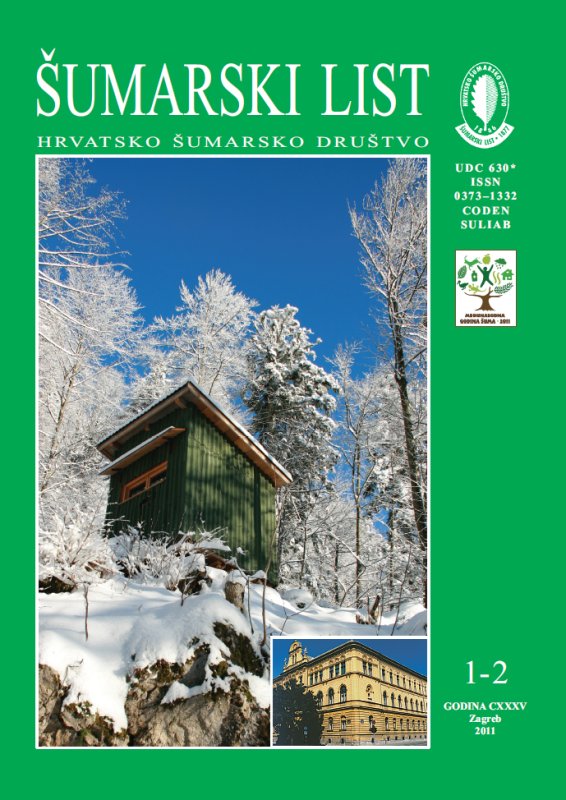
broj: 1-2/2011
pdf (4,93 MB) |
|
||||||||||||||
| RIJEČ UREDNIŠTVA | ||
| Uredništvo | ||
| ON COMPANIES AND CONCESSIONS pdf HR EN | 1 | |
| IZVORNI ZNANSTVENI ČLANCI | ||
| Krapinec, K., D. Konjević, I. Brezovac, L. Manojlović, K. Severin, V. Njemirovskij, M. Grubešić, K. Tomljanović | UDK 630* 156 (001) | |
| Some Morphological Characteristics of Wild Boar Tusks and Evaluation of Aging Methods pdf HR EN | 7 | |
| Kobal, M., M. Urbančič, N. Potočić, B. De Vos, P. Simončič | UDK 630* 114.2 (001) | |
| Pedotransfer Functions for Bulk Density Estimation of Forest Soils pdf HR EN | 19 | |
| Pekeč, S., B. Vrbek, S. Orlović, B. Kovačević | UDK 630* 232.3 + 114.2 (001) | |
| Production Potencial of Black Poplar (Section Aigeiros Duby) on Eugley pdf HR EN | 29 | |
| PREGLEDNI ČLANCI | ||
| Mamut, Marica | UDK 630* 431 | |
| Ties Between the Geographical and Social Geographical Features of Dalmatia with the Endangerment of Forest Fires pdf HR EN | 37 | |
| Summary: Forest fires across the croatian mediterranean area are assuming alarming proportions and are almost an integral part of the summer season, which are confirmed by numerically processed data for Dalmatia in this paper. The analysis of ties between the geographical and social geographical features of dalmatia with the endangerment of forest fires was conducted on the basis of official data obtained from MUP RH for the regions of four police departments (PU Split-Dalmatia, Dubrovnik-Neretva PU, PU Sibenik-Knin and Zadar PU). The natural and social characteristics of the Dalmatian region have a great influence on the emergence and spread of fires. Demographic discharge and the aging population of the coastal region is closely associated with economic re-orientation of the population (transition from agriculture and livestock to tourism) and are thus creating new areas of fire hot spots. Travel orientation of this area includes a large frequency of people (tourists) in the summer when the climate is very favorable for the occurrence of fire. The Dalmatian region belongs to the climate type and subtype Cs Csa with very high summer temperatures (. 22 °C) and a very rare and weak precipitation as a Mediterranean forest ecosystem of coniferous and broad-leaved evergreen makes it flamable. Dalmatian karst area (cca 80%) is mostly composed of hard and solid limestone which makes the area very flow through and further enhances the lack of surface water, mechanical wear surfaces, removal of soil and shortage of vegetation. This situation contributes to the favorable conditions for the occurrence of fires in the open. In the period of 1998–2008, out of all the forest fires in Croatia 31.7% (29 100 fires) was recorded in the dalmatian region. The greatest number of forest fires was recorded in the PU Split-Dalmatia (in the year 2000, more than 1,400 fires) while the highest burned area in this period was recorded in the PU Sibenik-Knin (68,235 ha). Within the Dalmatian region the larger part of the Croatian forest was burnt (even 122 241 ha or 64.3% of forest area burned RH). In the period from 1998 to 2007, the total forest area burned in the high forest dominated by pine forest attributes to only 11.6% (19 839 ha). Most of the forest area (85 690 ha or 50.2%) before the fire was covered with coppice forests, brush thickets and scrubs. In the structure of the burned open spaces of the dalmatian region , forests and forest lands are represented with 122 241 ha (53.5%), agricultural area with 25 334 ha (11.1%), the landfill with 4 106 ha (1.8%) and everything else seems 33.6% of burned area of open space. From the sociographic and economic aspects data on the ownership of burned area and the causes of these fires are very valuable. The analysis of property ownership of the burned area showed that the majority of fires occurred on the surfaces of undetermined ownership (73.2% in Croatia, the Dalmatian area 53.7%). The largest number of fires (75%) were caused by negligence, of which 23% of agricultural areas. The greatest damage from fires are lost human lives but also damage to soil and vegetation and damage which directly affect human life. Dalmatian region participated with 71.3% of the total damages from fires in Croatia. The fire prevention and rehabilitation of the open areas of Croatia has a great importance to local government, Croatian Forestes Ltd., police, fire legislation and institutions where it is necessary to implement short and long term measure. Key words: Dalmatia; fires; forest area; geographical features; social geographical features. openland | ||
| STRUČNI ČLANCI | ||
| Španjol, Ž., D. Barčić, R. Rosavec, B. Dorbić | UDK 630* 907 | |
| Biological-Ecological and Spatial Valorisation of Protected Natural Values in northwest Croatian Counties pdf HR EN | 51 | |
| Sindičić, M., D. Zec, Đ. Huber | UDK 630* 450 | |
| Analysis of Brown Bear Damages in Croatia in the Period from 2004 until 2009 pdf HR EN | 63 | |


